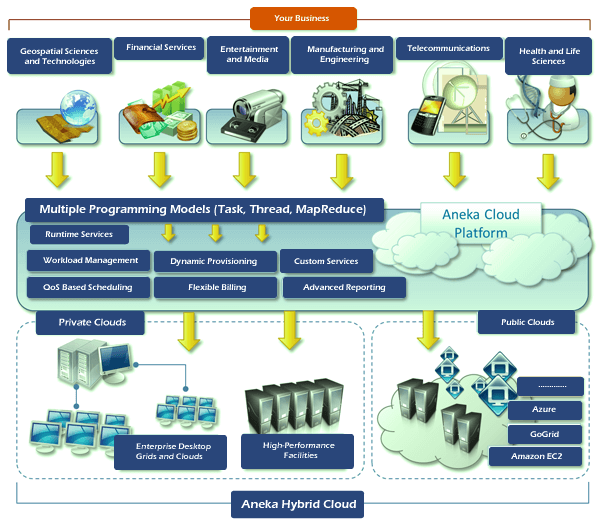Aneka in Cloud Computing
Aneka includes an extensible set of APIs associated with programming models like MapReduce.
These APIs support different cloud models like a private, public, hybrid Cloud.
Manjrasoft focuses on creating innovative software technologies to simplify the development and deployment of private or public cloud applications. Our product plays the role of an application platform as a service for multiple cloud computing.
- Multiple Structures:
- Aneka is a software platform for developing cloud computing applications.
- In Aneka, cloud applications are executed.
- Aneka is a pure PaaS solution for cloud computing.
- Aneka is a cloud middleware product.
- Manya can be deployed over a network of computers, a multicore server, a data center, a virtual cloud infrastructure, or a combination thereof.
Multiple containers can be classified into three major categories:
- Textile services
- Foundation Services
- Application Services
1. Textile Services:
Fabric Services defines the lowest level of the software stack that represents multiple containers. They provide access to resource-provisioning subsystems and monitoring features implemented in many.
2. Foundation Services:
Fabric Services are the core services of Manya Cloud and define the infrastructure management features of the system. Foundation services are concerned with the logical management of a distributed system built on top of the infrastructure and provide ancillary services for delivering applications.
3. Application Services:
Application services manage the execution of applications and constitute a layer that varies according to the specific programming model used to develop distributed applications on top of Aneka.
There are mainly two major components in multiple technologies:
The SDK (Software Development Kit) includes the Application Programming Interface (API) and tools needed for the rapid development of applications. The Anka API supports three popular cloud programming models: Tasks, Threads and MapReduce;
And
A runtime engine and platform for managing the deployment and execution of applications on a private or public cloud.
One of the notable features of Aneka Pass is to support the provision of private cloud resources from desktop, cluster to a virtual data center using VMware, Citrix Zen Server, and public cloud resources such as Windows Azure, Amazon EC2, and GoGrid cloud service.
Aneka’s potential as a Platform as a Service has been successfully harnessed by its users and customers in three different areas, including engineering, life sciences, education, and business intelligence.
Architecture of Aneka

Aneka is a platform and framework for developing distributed applications on the Cloud. It uses desktop PCs on-demand and CPU cycles in addition to a heterogeneous network of servers or datacenters. Aneka provides a rich set of APIs for developers to transparently exploit such resources and express the business logic of applications using preferred programming abstractions.
System administrators can leverage a collection of tools to monitor and control the deployed infrastructure. It can be a public cloud available to anyone via the Internet or a private cloud formed by nodes with restricted access.
A multiplex-based computing cloud is a collection of physical and virtualized resources connected via a network, either the Internet or a private intranet. Each resource hosts an instance of multiple containers that represent the runtime environment where distributed applications are executed. The container provides the basic management features of a single node and takes advantage of all the other functions of its hosting services.
Services are divided into clothing, foundation, and execution services. Foundation services identify the core system of Anka middleware, which provides a set of infrastructure features to enable Anka containers to perform specific and specific tasks. Fabric services interact directly with nodes through the Platform Abstraction Layer (PAL) and perform hardware profiling and dynamic resource provisioning. Execution services deal directly with scheduling and executing applications in the Cloud.
One of the key features of Aneka is its ability to provide a variety of ways to express distributed applications by offering different programming models; Execution services are mostly concerned with providing middleware with the implementation of these models. Additional services such as persistence and security are inverse to the whole stack of services hosted by the container.
At the application level, a set of different components and tools are provided to
- Simplify the development of applications (SDKs),
- Port existing applications to the Cloud, and
- Monitor and manage multiple clouds.
An Aneka-based cloud is formed by interconnected resources that are dynamically modified according to user needs using resource virtualization or additional CPU cycles for desktop machines. A common deployment of Aneka is presented on the side. If the deployment identifies a private cloud, all resources are in-house, for example, within the enterprise.
This deployment is enhanced by connecting publicly available on-demand resources or by interacting with several other public clouds that provide computing resources connected over the Internet.
